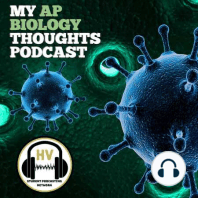6 min listen
Water… The Universal Solvent
ratings:
Length:
8 minutes
Released:
Apr 5, 2021
Format:
Podcast episode
Description
My AP Biology ThoughtsUnit 1 Episode #34Welcome to My AP Biology Thoughts podcast, my name is Morgan Bernstein and I am your host for episode #34 in (Unit 1 Macromolecules: (Water, the Universal Solvent)). Today we will be discussing the properties of water that make it the universal solvent.Segment 1: Introduction to water as a universal solventWater is a molecule- two hydrogen atoms and one oxygen atom, chemical formula of H2O. Bonds= chemical properties Bonds within water are covalent bonds (extremely strong so a lot of energy to break a water molecule apart)Important bond with water is hydrogen bond- between water molecules instead of within. Occurs when a hydrogen is bonded to electronegative atoms, Nitrogen, Fluorine, Oxygen. The reason this bond is so special is because of the polarity of water molecules. electrons are not shared equally between atoms.Hydrogen atoms are partially positive where oxygen atoms are partially negative. When it joins with another water molecule, the partially negative oxygen atom gravitates towards the partially positive hydrogen atom, forming our hydrogen bond.Lastly, we need to know what a solvent is in order to understand why water is known as the universal one. A solvent is a substance that is able to dissolve another substance, in order to make a solution. Water is known as the universal solvent Segment 2: Example of solutes in watersoluble= salt, sugar, food coloring and coffee. insoluble= oil, flour and sand. The partially positive hydrogen atoms and partially negative oxygen atoms in water that make it polar are also the reason that so many substances are soluble in water. In salt, the partially negative chlorine atom in salt will automatically be attracted to the partially positive hydrogen atom in the water. Vice versa, the partially positive sodium atom will be attracted to the partially negative oxygen atom. Then the weak hydrogen bonds break and salt can dissolve On the other hand, something like oil will never be able to dissolve in water, because it is nonpolar. sharing of electrons within oil is even, no partially positive or partially negative charge. Not attracted to either part of the water molecule and the hydrogen bonds don't break, two substances never mixEven though it is not able to dissolve nonpolar substances, water is known as the universal solvent because it is able to be a solvent for more solutes than any other substanceSegment 3: Digging Deeper into the properties of waterWater as a universal solvent has many other connections to our unit of macromolecules and biology in general.One variable that affects the solubility of water is temperature. Increased temperature means higher kinetic energy means higher solubility. Salt dissolves more in boiling water than in ice. Another important fact when considering solubility is saturation. When all bonds are formed between water and salt, solution is saturated and no more dissolves.When talking about macromolecules, water plays an important role as well. Carbs- soluble, but less soluble as becomes polysaccharideLipid- soluble polar glycerol head but nonpolar insoluble fatty acid tail. Overall mostly insoluble.Proteins-depends on shae and r groupNucleic acids- mostly soluble, dna and rnaAdhesion- water sticks to other things ex leafCohesion- water sticks to itself ex on penny Thank you for listening to this episode of My AP Biology Thoughts. For more student-ran podcasts and
Released:
Apr 5, 2021
Format:
Podcast episode
Titles in the series (100)
Endotherms and Ectotherms by My AP Biology Thoughts
